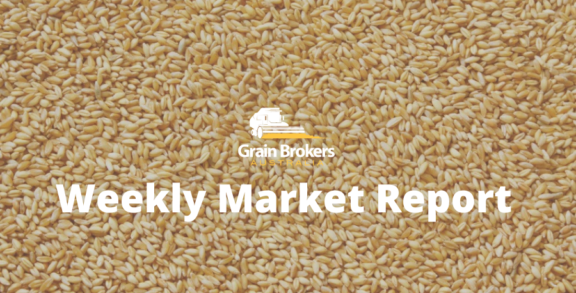The Mexican winter crop harvest is well underway, but the production outlook has been severely affected by extremely dry weather conditions, resulting in a decrease in the planted area of both wheat and corn and a dramatic reduction in the crop yield.
Mexico’s national water authority, Conagua, says this season’s severe drought has intensified, and the country is facing the worst conditions since 2011. This is not only drastically reducing the availability of irrigation water for crops and potable drinking water for the burgeoning population but also increasing tensions with the United States, its biggest trading partner, over a 70-year-old water treaty.
Under the treaty, Mexico is required to release 1.75 million acre-feet (1 acre-foot = 1.233 million litres) of water every five years to the US from six tributaries that feed into the Rio Grande, the fifth longest river of North America. In exchange, the US delivers water back to Mexico via the Colorado River, the eighth-longest river on the continent. Now into the fourth year of the current five-year cycle and Mexico has only supplied around 30 per cent of its obligations as it concentrates on domestic water needs and keeping its farmers pacified.
Virtually all of Mexico’s wheat area is irrigated, and adequate dam water levels are essential to encourage seeding in the November to February planting window and supply sufficient irrigation water to maintain yield expectations through to harvest. However, dam levels in the state of Sonora, which accounts for more than 50 per cent of domestic wheat output, were at a record low of just 18 per cent in February. Likewise, in Guanajuato, the second biggest wheat producing state, where historically low water storage levels forced farmers to cut wheat plantings this season.
According to the latest update from the USDA’s Foreign Agricultural Service, 2023/24 wheat production is expected to be 3.1 million metric tonnes off an estimated harvest area of 500,000 hectares, for an average yield of 6.2 metric tonnes per hectare. This is down from its January estimate of 3.5mmt and 13.2 per cent lower than the 2022/23 crop, which finished at a tad under 3.6mmt.
Yields have steadily increased over the last six years from 5.2 metric tonnes per hectare in 2017/18 to 6.1MT/ha last year, based on higher irrigation levels. However, elevated input costs, poor seed technology, weather extremes, and inefficient use of available irrigation water remain obstacles to consistently increasing yields and production.
Wheat imports are forecast at 5.4mmt in the current marketing year, up from 5.2mt in 2022/23, offsetting the lower production and a slight increase in domestic demand from 7.8MMT to 7.9MMT. The complexion of Mexico’s wheat imports has changed dramatically over the past three years. In calendar year 2021, 80 per cent was sourced from the US, 13.4 per cent from Canada and bugger all from Russia. But in the first ten months of 2023, that changed to 60.5 per cent from the US, 19.3 per cent from Canada and 16.3 per cent from Russia.
Mexico is a significant supplier of durum wheat to the export market, with shipments expected to hit 0.9MMT in the 2023/24 marketing year. This is an increase of more than 12 per cent compared to 2022/23, primarily driven by increasing demand from key consumers. Algeria has traditionally been the primary destination, with the North African nation importing 73, 62 and 77 per cent of Mexico’s total durum exports in 2021, 2022 and 2023, respectively.
Corn output has also suffered at the hand of the multi-year drought conditions, with FAS forecasting a total 2023/24 production at 23.3MMT, 17 per cent lower than the previous season’s record crop of 28.1MMT. Mexico has two corn crops with around 70 per cent of output produced in the summer cycle, which is planted from April through to August and harvested in October through to January. The 30 per cent balance is winter corn which is sown in November, December and January and harvested in April through to July.
The decreased production estimate reflects official government data, which unveiled lower planted and harvested areas due to poor early season soil moisture and inadequate irrigation water supplies, crop damage due to pests and disease, and lower-than-expected yields across most of the country.
The planted area in the summer cycle reportedly declined by one per cent to 5.7 million hectares with final production expected to be around 17MMT. The unfavourable weather conditions throughout the season led to a four per cent yield decline year-on-year to an average of 3.24MT/ha. Output in Jalisco, Mexico’s largest summer corn producing state, was down around 31 per cent compared to 2022/23.
Low autumn and winter rainfall in key water catchments feeding the larger producing states resulted in a 33 per cent decline in the winter cycle corn area to around 800,000 hectares. According to FAS the worst affected states were Sinaloa, Tamaulipas and Sonora. Water storage levels in Sinaloa, which accounts for around 70 per cent of winter corn output, were only at 21 per cent of capacity in early February, 60 per cent lower than at the same time in 2023.
Mexico is the world’s fifth largest animal feed producer, with the country estimated to have produced over 43MMT of rations for domestic beef, poultry, swine, dairy, pet food, and aquaculture production in 2023. Over 50 percent of the animal feed includes corn and output is estimated to have grown by eight percent year-on-year. This has pushed feed and residual use of corn to a record 28mmt in 2023/24. Add the food, seed and industrial consumption of 18.6mmt, which is relatively static due to high food prices and domestic demand hits a record 46.6mmt in 2023/24.
The escalating demand profile is expected to see corn imports in Mexico’s 2023/24 marketing year increase to a record 21.1MMT, second only to China on the global trade table. However, any further fall in winter cycle corn output will be reflected in higher import requirements as projected ending stocks are already very tight. The US supplied more than 85 per cent of Mexico’s corn imports in the last calendar year, with geographic proximity, a sizeable exportable surplus and strong relationships pairing the US grain and Mexican livestock sectors the primary catalysts.
Call your local Grain Brokers Australia representative on 1300 946 544 to discuss your grain marketing needs.
Written by Peter McMeekin.





